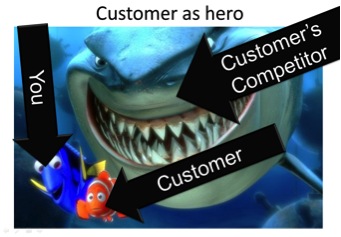You’re at an event, and you’re ready. You know your product inside out. You know the competition. You know the licensing terms. The deals. The partners. The competition. Technical details. Market details. Detail details. Regulations. Strengths. Compatibilities. Your head is stuffed. Crammed, just when – A customer comes to you. “I’ve got sixty seconds. Why should I buy from you?”
You spent years learning and studying and now you’ve got 30 seconds. You choke on your own knowledge. In this situation, has your strength, your deep product knowledge, actually become a weakness? What do you do? How do you convey so much information in such a small amount of time? It’s these situations, when a 100-slide PowerPoint deck or a technical demonstration is not possible, when it is critical to turn to the oldest form of persuasive communication in the world – the story.
Your customers are being constantly bombarded by myriad of marketing messages as well as other communication – emails, blogs, and social media. How do you make them notice your message and remember it when making a decision? The answer again is a story. Stories are powerful. Stories propagate thru centuries without any media coverage and advertising dollars. We hear stories in childhood and we repeat them to our children. And the story goes on. Consider these two announcements from two of the biggest product and SaaS companies.
Microsoft’s Jan 21, 2007 announcement
As Microsoft continues to deliver innovations to its unified communication and collaboration platform – which includes Microsoft Exchange Server 2007, the 2007 Office system with Microsoft Office SharePoint Server 2007, and has solutions in the pipeline such as the next generation of Microsoft Office Communications Server – Microsoft’s industry partners find that business is booming.
Google’s Oct 11, 2006 announcement
Ever found yourself trading email attachments with several colleagues, trying to collaborate on a document, only to have someone chime in at the last moment with corrections to an outdated version? Today, at the Office 2.0 Conference in San Francisco, Google launched a solution to these collaborative and document-management challenges: Google Docs & Spreadsheets
Which one do you think is easier to understand and remember? Which is stickier? The Google announcement has elements of a story as suggested by Heath brothers in their book Made to Stick.
Technical people are horrible at telling stories. It is tough for them to move from listing technical features to telling stories. Here is one way forward – apply to your writing the SUCCES framework suggested by Heath brothers in their book Made to Stick. They say a sticky message is simple, has an element of unexpectedness, is concrete and complete, makes an emotional connect and is told like a story. I strongly recommend the reader to get hold of the book and practice what the brothers suggest.
Here’s another example from GE – look at their site.
 Their lead story isn’t about the products they sell or the event they were at. At the core GE stands for innovation and they tell us about their innovations not by listing their innovations in a bulleted list with awards and partner logos attached, but by talking about their rich history, their leaders, their visions and their journey over time. It’s a rich narrative and something we can all learn from – the products are there but it’s not their lead.
Their lead story isn’t about the products they sell or the event they were at. At the core GE stands for innovation and they tell us about their innovations not by listing their innovations in a bulleted list with awards and partner logos attached, but by talking about their rich history, their leaders, their visions and their journey over time. It’s a rich narrative and something we can all learn from – the products are there but it’s not their lead.
You need to create your story or others will create it for you. – What is the narrative for Apple, What about Google or eBay? What would your narrative be? Remember to make your customer a hero!



